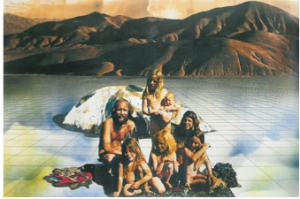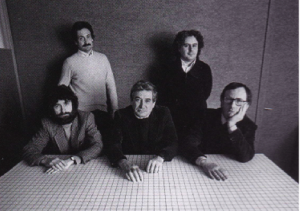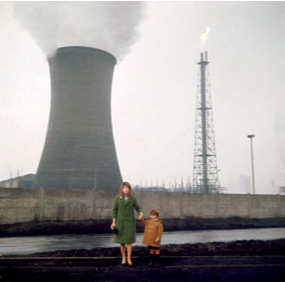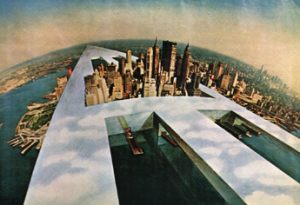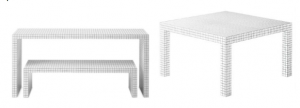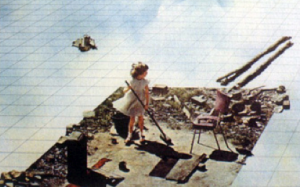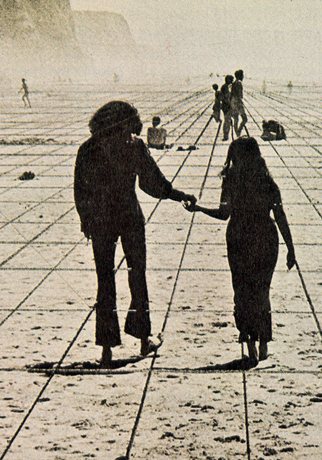Superstudio was founded in 1966 in Italy by Natalini, Torrelado di Francia, Alessandro, Roberto Magris and Piero Frassinelli. The group developed as a result of the expanding cities, which contributed to the growing amount of products and design. Later on they focused more on architecture and they did cut-outs and city plans of over expanding cities.
In the 60s the post-war modernization was a fact in Italian society and decimating the surrounding urban landscape. Mussolini’s fascist regime contributed to the invitation of Italian mass society, but did not construct a mass consumer culture. That would be the accomplishment of the governments who supported private investment. There
was no sufficient safety regulation to ensure proper building methods. The result was catastrophic, with speculative buildings placed randomly through the urban margin. Italians were becoming more urban and more hooked with their object world, but adapting to this new consumer oriented lifestyle unavoidably meant that they came apart to traditional habits.
During this time the student population doubled to half a million, providing a force behind the rise of mass student culture. This slide towards social breakdown was brought into view through the work of some of the countries artists. Like Michelangelo Antonioni who with his film “Red dessert” showed a devastated landscape with factories and pollution. This was a reminder of a simpler past and reflected on the built environment.
In order to understand Superstudio it is essential to know the political situation in Italy and also the university climate in Florence during the 60s. Florence government resisted any form of non-traditional modernisation, so the more innovative the faculties found themselves isolated and they cold even be rejected to participate in the cities architectural development. It was there in the rebellious youth culture the grounder of Superstudio was born, Natalini and Torelado, after graduated at Florence School of Architecture. They found each other in the depth of frustration that was unique to the young generation studying in Florence.
Later on they started collaborate with the group “Archizoom” and formed the group “Superarchitecture”, a design studio that was founded during the same time in Florence. This was a group from England consisted of 6 people. In 1963 they had the exhibition “Living cities” that involved their theory about survival technology and they experimented with modular technology, space capsules and mass- consumer imagery. Their works offered a seductive vision of a glamorous future machine age; however, social and environmental issues were left unaddressed.
“Continious monument” is a photo-collage series that shows different environments wrapped around by gridded superstructures. They started out this project with carefully reasoned historical thesis on the nature of cultural monuments and evolve into a system of architectural domination. The growth of the monument across the global landscape is shown as its own neutralizer, thereby putting an end to its sublime terror.
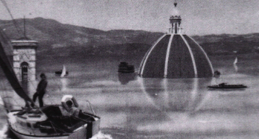 Rescue of historic centres 1970
Rescue of historic centres 1970
They often used satirical irony in their films and cut-outs as a medium to call into question the meaning of architecture itself. The way global design, planning and construction were going; everyone might as well lives in functional spaces free from individual expressions. A continuous global grid could replace everything.
I like the fact that their plans never became reality but their concepts were sold and exhibited. They established radical surrealistic visions of negative environment as critiques of contemporary movement. They lived in a time when it was hard to escape from the time pressure and the fast development. Then like now, designers have to go outside expectations and think further and in the end present authentic products, sometimes-overdeveloped products. What Superdstudio did (in some of their work) was that they stopped during the process of development and did not finish it. This was a revolutionary way of thinking during that time. It is a concept that allows the spectators to walk into an unfinished world.
Superstudio has influenced a lot of designers and architectures today with its radical and revolutionary ideology. Rem Koolhaas is one of them who have made a lot extravagant projects. There is a similarity of the buildings he does and in Superstudios sketches. He is also more interested in the city and urbanisation and in a contradiction way he build dynamic, futuristic buildings.
“ If design is merely an inducement to consume, then we must reject design. If architecture is merely the codifying of bourgeois model of ownership and society, then we must reject architecture. If architecture and town planning is merely the formalization of present unjust social divisions, then we must reject town planning and its cities until all design activities are aimed towards meting primary needs. Until then, design must disappear. “
Like I said their plans never became reality but their concepts were sold and exhibited and that is one reason I think they are more like artists then designers. They used their designer skills and knowledge but pushed it further so their work became artworks. A designer solves problems and an artist asks questions. Superstudio asked questions. They gave one solution out of millions and force the spectator to use his imagination to expand this solution.
In 1970 they did a furniture collection out of their “Grid concept”. It is a 3d object out of their drawings, so from design they made art, and from art they designed. But how come they neglected design when they at the same time were involved in it and produced? Is it fair to their belief? It is a dilemma to understand Superstudio and their nearly schizophrenic position between architectures theoretical and practical application. What they designed here was a response on the political issues that existed during that time and the disillusionment, which gave origin to a new society, which off course affected the art world. In the end they designed aesthetic object and political instruments.
Quaderna 710
“It is the designers who must attempt to re-evaluate his role in the nightmare he helped to conceive, to retread the historical process which inverted the hopes of the modern movement.”
They were constantly working in the artist section, but when they were searching for the solutions to an alternative lifestyle without objects in the society, the outcome were a result of their long design and architecture studies. And instead of total neglecting of objects the conclusion is an almost ironic and definitely critique products.
